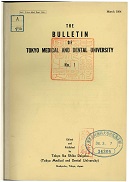巻号一覧

39 巻 (1992)
- 4 号 p. 63-
- 3 号 p. 55-
- 2 号 p. 31-
- 1 号 p. 1-
39 巻, 1 号
選択された号の論文の3件中1~3を表示しています
- |<
- <
- 1
- >
- >|
-
Yu-Faang LIN, Yoshiaki ONO, Hiroshi ONO1992 年 39 巻 1 号 p. 1-7
発行日: 1992年
公開日: 2019/10/02
ジャーナル オープンアクセスThe mandible has two major parts, the corpus and the ramus. These two parts must be considered separately because each has its own functional counterpart with the maxilla and the posterior cranial base. Since the mandible is a single bone, the border of the corpus and the ramus can not be visualized on the conventional two-dimensional lateral cephalometric radiograph. The purpose of this study is to propose a reliable method to distinguish the border between the mandibular corpus and the ramus on the lateral cephalometric radiograph. In this study, 64 dried skulls in different developmental stages were examined. Metallic markers were placed at the diverging point (point T) on both sides of the dried skulls. From the occlusal view of the mandible, point T was considered to be the lingual border of the corpus and the ramus. Then, the lateral cephalometric radiographs of the dried skulls were taken. On each lateral cephalometric radiograph, a vertical line L was drawn from point Ra (the intersection of the occlusal plane and the anterior border of the ramus) to the mandibular plane. Thus, the distance from the midpoint of point T on each side to the vertical line L was measured. As a result, over 80% of the midpoints T were found on the vertical line L. Therefore, the vertical line L from point Ra to the mandibular plane can be considered to play the role of a reasonable reference line for distinguishing between the corpus and the ramus on the lateral cephalometric radiograph.抄録全体を表示PDF形式でダウンロード (671K) -
Tetsuo WAKABAYASHI1992 年 39 巻 1 号 p. 9-17
発行日: 1992年
公開日: 2019/10/02
ジャーナル オープンアクセスAlthough insulin is known to have various actions on the cardiovascular system, its effects on the microvessels in vivo have not been fully elucidated. This study was aimed to examine the effects of the increased endogenous insulin release after meals on the reflex vasoconstriction induced by cold exposure in the rabbit ears using a laser Doppler flowmeter. A reflex blood flow reduction by cold exposure was tested 3-4 hours after meals in the rabbits with or without pretreatment with a somatostatin analogue (Sandostatin, 100 μg/body). The degrees of the blood flow reduction were decreased after the diet intake compared to the responses in the fasting state. The blood flow reduction after diet intake in the non-treated group was significantly attenuated compared to the treated group (88.4±13.0% in the non-treated group vs. 47.5±13.4% in the treated group at 1 minute of cold exposure; p<0.05, and 87.6±20.2% vs. 40.2±24.8%, respectively, at 5 minutes of cold exposure; p<0.05). The somatostatin-treated rabbits showed a significant suppression of the increase in the serum insulin levels after meals compared to the non-treated control rabbits (17.8±10.2 µU/ml in the treated group vs. 78.6±38.3 µU/ml in the non-treated group, p<0.05). In the somatostatin-treated rabbits, the exogeneously applied insulin caused a decreased response of blood flow to cold exposure. These findings suggest that in the postprandial state the endogenous insulin release may regulate the reactivity of the microvessels to the sympathetic stimuli.抄録全体を表示PDF形式でダウンロード (857K) -
Kiyoshi HIRASAWA, Morioki FUJITANI, Hiroyasu HOSODA1992 年 39 巻 1 号 p. 19-29
発行日: 1992年
公開日: 2019/10/02
ジャーナル オープンアクセスRecently, problems have occurred frequently such as cervical and exposed dentin surface lesions or root caries and subsequent hypersensitivity because of further increase of the elderly population. This study was projected to devise a proper and simple treatment and materials for the adhesive composite restoration for such lesions. The 10-20Ca (10% citric acid containing 20% calcium chloride) solution was found to be a comparatively mild tooth surface conditioning agent and to be effective with a single application to both dentin and enamel. In addition, the use of the SA primer (3% N-methacryloyl 5-aminosalicylic acid in 80% ethanol) and the LVR (visible light-cured, 33% microfilled low viscous Bis-GMA resin) dramatically improved the adhesion and adaptability of the composite restoration in the saucer cavity at the cervical area.抄録全体を表示PDF形式でダウンロード (1629K)
- |<
- <
- 1
- >
- >|